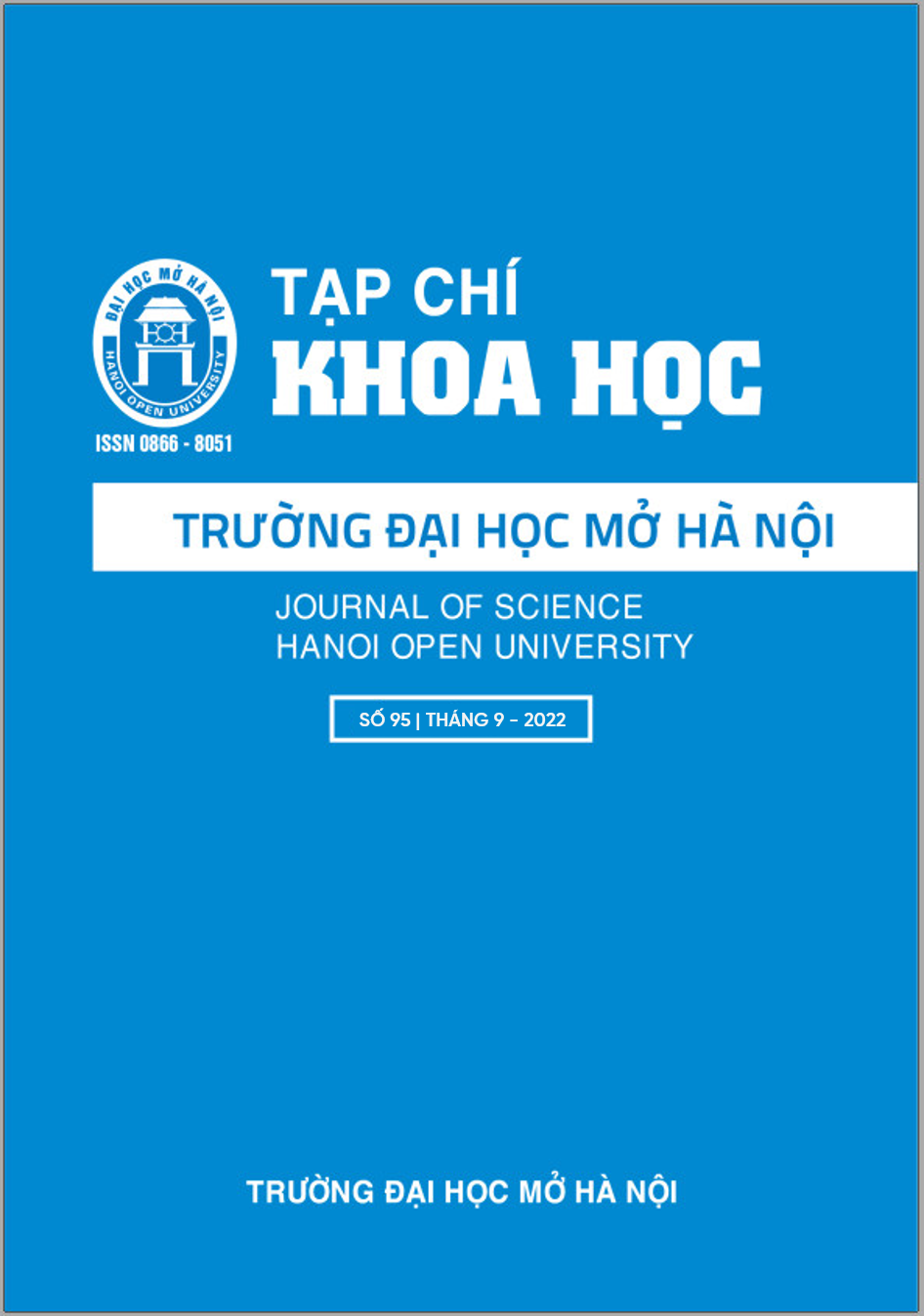NGHIÊN CỨU ĐẶC ĐIỂM SINH HỌC CỦA CHỦNG XẠ KHUẨN CH9.4 PHÂN LẬP TỪ ĐẤT TRỒNG TRỌT HUYỆN QUỐC OAI, HÀ NỘI
Từ khóa:
chất kháng sinh, xạ khuẩn, Streptomyces, polyketide,vi khuẩnTóm tắt
Trong môi trường đất, Streptomyces thường chiếm tỷ lệ chính trong tổng số quần thể xạ khuẩn và được công nhận là nguồn cung cấp phong phú các hợp chất có hoạt tính sinh học hữu ích. Chủng xạ khuẩn CH9.4 được phân lập từ đất trồng trọt huyện Quốc Oai, Hà Nội thể hiện hoạt tính sinh học cao, kháng cả vi khuẩn Gram âm và Gram dương, sinh trưởng tốt trên nhiều loại môi trường nuôi cấy với nhiệt độ sinh trưởng tối ưu là 28OC, pH 7,5. Dựa vào nghiên cứu đặc điểm sinh học và phân tích trình tự gen mã hóa 16S rDNA, chủng CH9.4 có độ tương đồng cao với chủng Streptomyces cinnamonensis, do đó được đặt tên là S. cinnamonensis CH9.4. Phân tích sự có mặt của gen chức năng liên quan đến sinh tổng hợp kháng sinh cho thấy chủng S. cinnamonensis CH9.4 mang gen mã hóa polyketide loại 2. Như vậy chủng S. cinnamonensis CH9.4 có tiềm năng cao trong nghiên cứu sinh tổng hợp kháng sinh từ vi sinh vật.
Tài liệu tham khảo
[1]. R. Müller, J. Wink , Future potential for anti-infectives from bacteria—How to exploit biodiversity and genomic potential. Int. J. Med. Microbiol, 304:3–13, (2014) .
[2]. Y. Widyastuti, P. Lisdiyanti, S. Ratnakomala, G. Kartina, R. Ridwan, R.Rohmatussolihat, N. Rosalinda Prayitno, E. Triana, N. Widhyastuti, et. al., Genus diversity of Actinomycetes in Cibinong Science Center, West Java, Indonesia, Microbiol, 6:165–172, (2012).
[3]. X. Lucas, C. Senger, A. Erxleben, B.A. Grüning, K. Döring, J. Mosch, S. Flemming, S. Günther, StreptomeDB: A resource for natural compounds isolated from Streptomyces species. Nucleic Acids Res, 41:D1130–D1136, (2013).
[4]. M. Igarashi, Y. Takahashi, T. Shitara, H. Nakamura, H. Naganawa, T. Miyake, Y. Akamatsu, Caprazamycins, novel lipo- nucleoside antibiotics, from Streptomyces sp, J. Antibiot, 58:327–337, (2005).
[5]. S. Dutta, B. Basak, B. Bhunia, S. Chakraborty, A. Dey, Kinetics of rapamycin production by Streptomyces hygroscopicus MTCC 4003. 3 Biotech, 4:523–531, (2014).
[6]. L. Rodríguez, D. Rodríguez, C. Olano, A.F. Braña, C. Méndez, J.A. Salas, Functionalanalysis of OleY L-oleandrosyl 3-O-methyltransferase of the oleandomycin biosynthetic pathway in Streptomyces antibioticus, J. Bacteriol., 183:5358–5363, (2001).
[7]. M. Elibol, Optimization of medium composition for actinorhodin production by Streptomyces coelicolor A3(2) with response surface methodology, Process Biochem, 39:1057–1062, (2004).
[8]. A.R. Pokhrel, A.K. Chaudhary, H.T. Nguyen, D. Dhakal, T.T. Le, A. Shrestha, K. Liou, J.K. Sohng, Overexpression of a pathway specific negative regulator enhances production of daunorubicin in bldA deficient Streptomyces peucetius ATCC 27952, Microbiol. Res., 192:96–102, (2016).
[9]. B.S. Moore, J.N. Hopke, Discovery of a new bacterial polyketide biosynthetic pathway, ChemBioChem, 2:35–38, (2001). [10]. J.S. Rokem, A.E. Lantz, J. Nielsen, Systems biology of antibiotic production by microorganisms, Nat. Prod. Rep., 24:1262, (2007).
[11]. Y. Katsuyama, N. Funa, I. Miyahisa, S. Horinouchi, Synthesis of unnatural flavonoids and stilbenes by exploiting the plant biosynthetic pathway in Escherichia coli, Chem. Biol, 14:613–621, (2007).
[12]. I. Chopra, M. Roberts, Tetracycline antibiotics: Mode of action, applications, molecular biology, and epidemiology of bacterial resistance tetracycline antibiotics: Mode of action, applications, molecular biology, and epidemiology of bacterial resistance, Microbiol. Mol. Biol. Rev., 65:232–260, (2001).
[13]. M.A. Ghannoum, L.B. Rice, Antifungal agents: Mode of action, mechanisms of resistance, and correlation of these mechanisms with bacterial resistance, Clin. Microbiol. Rev., 12:501–517, (1999).
[14]. O. Tacar, P. Sriamornsak, C.R. Dass, Doxorubicin: An update on anticancer molecular action, toxicity and novel drug delivery systems, J. Pharm. Pharmacol., 65:157–170, (2013).
[15]. M.A.M. Shushni, R. Singh, R. Mentel,
U. Lindequist, Balticolid: A new 12-membered macrolide with antiviral activity from an Ascomycetous fungus of marine origin, Mar. Drugs, 9:844–851, (2011).
[16]. J. Li, S.G. Kim, J. Blenis, Rapamycin: One drug, many effects, Cell Metab, 19:373– 379, (2014).
[17]. N.W.C.J. Van de Donk, M.M.J. Kamphuis, H.M. Lokhorst, A.C. Bloem, The cholesterol lowering drug lovastatin induces cell death in myeloma plasma cells, Leukemia, 16:1362–1371, (2002).
[18]. H. Nomomura, Key for classification and identification of 458 species of the Streptomyces included in ISP, J. Ferment. Technol. 52(2) (1974) 78.
[19]. W. Wilkins, Bergey’s Manual of Systematic Bacteriology, Vol. 2, Vol. 3, Vol. 4. Publisher Springer- Verlag, NY, (1989).
[20]. E. Shirling and G. D. Gottlieb, Methods for characterization of Streptomyces species, Int J Syst Bacteriol, vol. 16, pp. 313-340, (1966). [21]. H.D. Tresner , E.J. Buckus,, System of color wheels for Streptomyces taxonomy, Appl Environ Microb 11: 335–338, (1963). [22]. Stanley T. Williams M. E. Sharpe, J.
G. Holt, Bergey’s Mannual of Systematic bacteriology, Williams & Wilkins, 4: 2452- 2492, (1989).
[23]. J. Sambrook , D. Russell, Molecular Cloning: a Laboratory Manual, 3rd. Cold Spring Harbor, NY: Cold Spring Harbor Laboratory, (2001).
[24]. M.K. Mikko, S. Virpi, H. Laura, H. Anne, H. Juha, M. Pekka, Y. Kristiina, An efficient approach for screening minimal PKS genes from Streptomyces, FEMS Microbiol Lett 180: 1-6, (1999)
[25]. B. Sirisha, R. Harith, J. Mohan, K. Siva, K. S. Kumar, and T. Ramana, Bioactive compounds from marine actinomycetes isolated from the sediments of bay of Bengal, IJPCBS, vol. 3, no. 2, pp. 257-264, (2013).
[26]. Kumar S., Stecher G., Li M., Knyaz C., and Tamura K., MEGA X: Molecular Evolutionary Genetics Analysis across computing platforms. Molecular Biology and Evolution 35:1547-1549, (2018).
